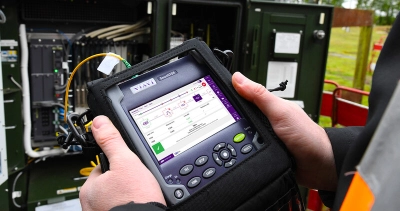Ofda plays a key role in accurate fibre measurement in different applications.
Ofda plays a key role in accurate fibre measurement in different applications.
Blog Article
Discover the Importance of Optical Fibre Screening in Modern Telecom
In the realm of contemporary telecommunications, the importance of optical fibre screening can not be overemphasized, as it serves as the backbone for making sure network integrity and efficiency. By executing regular testing procedures, operators can preemptively determine possible issues such as signal deterioration, therefore guarding against disruptions that might verify expensive. Advanced methods like Optical Time-Domain Reflectometry play an essential function in this procedure, yet lots of may overlook the broader implications of these practices. What are the particular benefits that regular testing offers, and how might it form the future landscape of telecoms?

Comprehending Optical Fiber Testing
Optical fibre screening is a critical process in telecommunications that ensures the honesty and efficiency of fibre optic networks. This screening includes an array of procedures developed to evaluate the physical and useful qualities of optical fibres - ofda. Key criteria examined include optical power loss, data transfer capacity, and mistake location, which are important for maintaining top notch communication web links
The screening procedure typically includes making use of customized equipment such as Optical Time-Domain Reflectometers (OTDR) and Optical Power Meters. OTDRs are employed to identify and identify mistakes, splices, and ports within the fibre, while power meters gauge the transmitted light signal strength to identify efficiency.
In addition, testing is carried out at various phases, consisting of during setup, upkeep, and troubleshooting, to guarantee that the network meets market criteria and operational demands. Conformity with criteria set by organizations like the International Telecommunication Union (ITU) and the Telecoms Sector Association (TIA) is vital.
Advantages of Regular Checking
Routine screening of optical fibers yields various benefits that significantly improve network integrity and efficiency. One of the primary benefits is the early detection of prospective issues, such as breaks or degradation in the fibre, which can result in expensive downtime if left unaddressed (optical fibre testing equipment). By identifying these issues proactively, telecommunications providers can reduce service disruptions and guarantee regular connection for their consumers
In addition, normal screening aids to preserve the stability of signal high quality. As optical fibers age, their performance can be impacted by elements such as ecological problems and physical anxiety. Routine evaluations enable the surveillance of signal loss and total transmission efficiency, ensuring that the network runs at optimal levels.
An additional significant advantage is compliance with sector criteria. Regular screening supports adherence to regulatory requirements, therefore alleviating legal and monetary threats related to non-compliance. It boosts the overall life expectancy of the fiber infrastructure by facilitating timely upkeep and repair work.

Common Checking Approaches
Testing optical fibres utilizes numerous methods to make sure the honesty and performance of telecommunications networks. Among one of the most usual strategies is Optical Time Domain Reflectometry (OTDR), which examines the whole size of the fiber by sending a pulse of light and determining the reflections triggered by imperfections or breaks. This technique supplies in-depth details concerning the area and severity of faults.
An additional common approach is making use of Optical Power Meters, which determine the amount of light sent via the fiber. This strategy aids establish the loss of signal toughness, ensuring that it meets industry standards. Additionally, Aesthetic Mistake Locators (VFL) are used to recognize breaks or serious bends in the fibre by forecasting a visible laser light into the cable.
Insertion loss screening is likewise critical, as it evaluates the loss of signal power arising from links and entwines within the network. Additionally, the use of Polarization Setting Dispersion (PMD) screening examines the effect of fiber characteristics on signal integrity.
Each of these methods plays a vital duty in preserving the efficiency and integrity of optical fibre networks, ultimately adding to seamless telecommunications procedures.
Influence On Network Performance
The integrity and efficiency of optical fibre networks straight influence overall network efficiency. In modern telecoms, the effectiveness of data transmission counts heavily on the top quality of the optical fibers used. Any kind of deterioration in the fiber's condition-- whether as a result of physical damages, contamination, or excessive flexing-- can cause increased depletion and signal loss, substantially impacting information integrity and rate.
Routine optical fibre testing is crucial to recognize and correct possible concerns before they show up as network failures or downturns. Strategies such as Optical Time Domain Reflectometry (OTDR) and insertion loss screening enable technicians to gauge the performance of fibre web links properly. These tests not only assess the physical problem of the fibres however additionally guarantee conformity with sector standards, therefore protecting the network's integrity.
Moreover, a well-kept optical fiber network adds to decreased functional prices and improved customer contentment, as end-users experience less interruptions and higher information prices. Ultimately, the emphasis on rigorous optical fibre testing methods works as a foundation for sustaining robust telecommunications facilities, making sure that company can fulfill the growing needs for check over here data transfer and connectivity in today's digital age.
Future Patterns in Checking
As we look in advance, innovations in technology are positioned to improve optical fiber screening useful content in telecommunications. The surge of automation and expert system (AI) is anticipated to boost the performance and precision of screening processes. Automated screening systems can perform thorough analyses with marginal human treatment, considerably decreasing the capacity for errors and speeding up time-to-deployment.
Additionally, the combination of device discovering algorithms will enable anticipating upkeep, enabling network suppliers to predict possible problems prior to they escalate into failings. This aggressive technique not only improves network integrity however also maximizes functional prices.
One more emerging fad is the advancement of portable screening gadgets that use real-time analysis - optical fibre diameter analyser. These gadgets will encourage service technicians to carry out on-site diagnostics swiftly, promoting quicker resolutions and enhancing service top quality
The growth of 5G networks further demands the development of screening methods. As bandwidth needs increase, standard testing strategies may no much longer are enough. Cutting-edge solutions such as optical time-domain reflectometry (OTDR) and progressed spooky analysis will certainly end up being crucial in making sure the integrity and performance of high-speed links.

Verdict
To conclude, optical fiber screening is important for guaranteeing the stability and integrity of contemporary telecoms networks. Normal testing methods not just help determine possible concerns such as signal loss and mistakes but also add to enhanced network performance and client contentment. As the need for Bonuses seamless connection continues to grow, the fostering of innovative screening methods will play an important duty in maintaining top notch network criteria and sustaining the evolving landscape of telecommunications.
Report this page